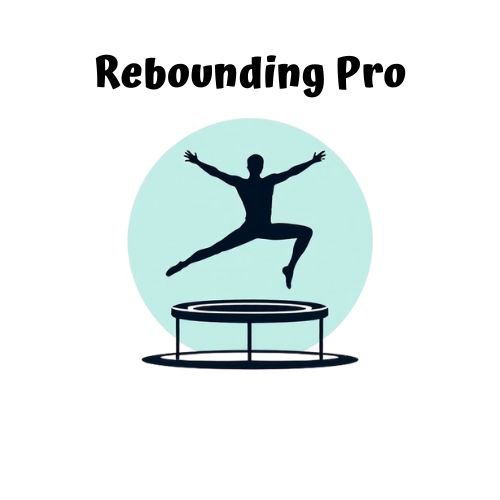Trampoline rebounding offers a low-impact exercise option for fibromyalgia sufferers. The gentle bouncing motion stimulates your lymphatic system, reduces inflammation, and releases natural painkillers to ease joint pain. You’ll benefit from improved circulation, stronger muscles, and enhanced range of motion without stressing sensitive joints. Start with just 2-5 minutes of gentle pulsing on a mini trampoline with a stability bar. Discover how this NASA-researched exercise approach can transform your pain management routine.
How Trampoline Rebounding Reduces Fibromyalgia Joint Pain

While many traditional exercises can exacerbate pain for fibromyalgia sufferers, trampoline rebounding offers a gentle yet effective alternative. The low-impact bouncing motion doesn’t stress your joints but still provides meaningful movement that reduces stiffness.
When you bounce, you’re increasing the circulation of synovial fluid, which lubricates your joints and decreases that morning stiffness you dread. The rhythmic up-and-down motion also stimulates your lymphatic system, helping reduce inflammation that contributes to joint pain.
Your muscles get stronger with each session, providing better support for painful joints. This improved muscle function enhances your proprioception and balance while decreasing overall pain sensitivity. For additional safety and stability, wearing specialized trampoline socks can improve your grip and prevent slipping during sessions.
You’ll likely notice improved range of motion as your body adapts to this gentle, supportive exercise.
The Science Behind Rebounding’s Low-Impact Benefits
When you bounce on a mini-trampoline, your body experiences controlled G-forces that distribute impact evenly, protecting sensitive fibromyalgia joints from the harsh jarring of traditional exercise.
This gentle bouncing activates your lymphatic system, which lacks its own pump, helping to clear toxins and reduce inflammation that contributes to pain. The low-to-the-ground design of rebounders provides stability, making them safer for people with balance issues common in fibromyalgia.
The rhythmic compression and release during rebounding creates a natural massage-like effect on tissues and vessels, enhancing circulation without the stress of weight-bearing activities.
G-Force Limits Joint Stress
Although trampolines generate significant g-forces—ranging from 6.9G to 14.6G depending on the trampoline type—these forces don’t translate to harmful joint stress.
NASA research confirms that rebounding limits extremity forces to a safe 4G maximum, protecting your joints while delivering effective exercise.
The trampoline’s design naturally minimizes joint impact through:
- Elastic surfaces that extend contact time during landings, distributing force peaks rather than concentrating them
- Spring systems that absorb shock and provide gradual deceleration, unlike hard surfaces
- Multi-directional force distribution that prevents rigid joint loading through micro-movements
These mechanisms make rebounding ideal for fibromyalgia sufferers.
You’ll experience full-body conditioning while the trampoline’s surface cushions impacts, converting what would be jarring movements into gentle, therapeutic bounces that stimulate circulation without aggravating pain points. Mini-trampolines with their smaller diameter design are particularly suitable for beginners with fibromyalgia, offering controlled movement within a limited space.
Lymphatic System Activation
The remarkable pain-relief benefits of rebounding extend far beyond the joint-friendly g-forces we’ve explored.
Your lymphatic system—your body’s internal cleansing mechanism—lacks its own pump and relies on movement to function properly.
When you bounce on a mini-trampoline, the alternating weightlessness and gravity create a pumping action that can increase lymphatic flow up to 15 times normal rates. This gentle bouncing opens and closes one-way valves throughout your lymphatic vessels, helping remove toxins, dead cells, and inflammatory compounds that may contribute to fibromyalgia pain. According to NASA research, this type of exercise is 68% more effective than traditional jogging for cardiovascular conditioning.
Just 10-15 minutes of gentle rebounding 3-5 times weekly can triple your white blood cell production, enhancing your immune response.
Unlike high-impact exercises, rebounding delivers these benefits without stressing your already sensitive joints.
Starting Your Gentle Trampoline Routine Safely

Safety comes first when beginning a trampoline routine for fibromyalgia pain management. Consult your healthcare provider before starting to verify rebounding is appropriate for your specific symptoms and health status.
Consult your doctor before starting any trampoline therapy for fibromyalgia—your safety is the priority.
They’ll help tailor the exercise to complement your existing treatment plan.
Choose a mini trampoline (rebounder) designed specifically for low-impact exercise with a stability bar for balance support. Wear non-slip socks to prevent accidents during your sessions.
- Start with just 2-5 minutes of gentle “pulsing” where your feet don’t leave the trampoline surface.
- Create a clutter-free, well-lit space with something stable nearby to hold if needed.
- Listen to your body—stop immediately if pain increases and adjust intensity based on how you feel.
Regular rebounding can be especially beneficial as it offers cardiovascular benefits while minimizing stress on painful joints.
Progressive Rebounding Exercises for Pain Management
Beginning your rebounding journey with progressive exercises helps maximize pain relief while minimizing potential flare-ups for those with fibromyalgia. Start with 5-10 minutes of gentle bouncing, focusing on deep breathing techniques to enhance relaxation. The gradual approach aligns with recommended exercise progression principles for fibromyalgia management.
Track your pain levels before and after sessions using a visual scale, and maintain a symptom journal to document your progress. Remember to include handrails for support if needed.
| Exercise Level | Benefits | Duration | Frequency | Modifications |
|---|---|---|---|---|
| Beginner | Improved circulation | 5-10 min | 2-3x weekly | Use handrails |
| Intermediate | Enhanced sleep | 10-15 min | 3-4x weekly | Add arm movements |
| Advanced | Better mental clarity | 15-20 min | 4-5x weekly | Integrate leg lifts |
| Recovery | Reduced inflammation | 5-15 min | As needed | Slower bouncing |
| Maintenance | Immune support | 10-20 min | 3-5x weekly | Full-body integration |
Selecting the Right Mini Trampoline for Fibromyalgia

When selecting a mini trampoline for fibromyalgia management, choosing the right equipment can greatly impact your pain relief results and overall exercise experience.
Look for models with heavy-gauge steel frames (at least 1.5mm thick) that won’t twist during use and can support your weight comfortably.
The ideal fibromyalgia-friendly rebounder should include:
Gentle bouncing doesn’t have to mean painful rebounding – the right features make all the difference for fibromyalgia relief.
- A smooth, gentle bounce from 32-40 galvanized springs rather than plastic ones
- Padded frame covers to protect joints during missteps
- Stability features like wide-stance curved legs and optional safety handles
Choose a 3-4 foot diameter trampoline with a durable, UV-resistant mat (60-100 denier). Starting with just 10 minutes of gentle rebounding can significantly improve your symptoms by releasing natural painkillers that help reduce fibromyalgia aches.
While budget options start at $30, mid-range models ($150-400) typically offer better durability and features essential for effective symptom management.
Complementary Practices to Enhance Rebounding Results
To maximize your rebounding benefits, you’ll need to incorporate mind-body techniques like meditation or gentle yoga that help manage fibromyalgia’s neurological symptoms while exercising.
Proper hydration before sessions and nutrient-rich foods afterward support muscle recovery and reduce post-exercise inflammation that might trigger flares.
Implementing specific recovery protocols—such as alternating rebounding days with rest periods and applying gentle heat therapy after sessions—can prevent symptom exacerbation while still maintaining progress. Consider adding portable far infra-red sauna sessions to your routine as they can effectively stimulate endorphin release for natural pain relief after rebounding exercises.
Mind-Body Integration Techniques
While rebounding on a trampoline offers physical benefits for fibromyalgia patients, incorporating mind-body integration techniques can greatly enhance your results.
These approaches help you manage pain perception while improving your emotional well-being during exercise. Research shows that 71% of people with fibromyalgia experience anxiety symptoms, making mind-body techniques particularly valuable.
Try integrating these practices with your rebounding routine:
- Practice deep breathing as you bounce, inhaling slowly for four counts and exhaling for six counts to activate your relaxation response.
- Incorporate guided imagery by visualizing pain melting away with each gentle bounce, directing your mind toward healing sensations.
- Use mindfulness techniques to stay present with each movement, acknowledging sensations without judgment.
Combining these mind-body approaches with your trampoline sessions creates a holistic treatment strategy that addresses both the physical and psychological aspects of fibromyalgia management.
Hydration and Nutrition
Proper hydration and nutrition serve as foundational pillars in maximizing your trampoline therapy results for fibromyalgia. When you’re well-hydrated, you’ll experience reduced inflammation and improved muscle function during rebounding sessions.
Aim for 11.5-15.5 cups of water daily, spread throughout your day to maintain consistent hydration levels. Remember that electrolytes are equally important—they regulate muscle contractions and nerve signals that can prevent painful spasms. Proper hydration helps maintain healthy synovial fluid in your joints, which is essential for comfortable movement during trampoline exercise.
| Nutrition Element | Benefit for Rebounding |
|---|---|
| Adequate Water | Reduces inflammation, improves muscle recovery |
| Electrolytes | Prevents muscle cramps during exercise |
| Magnesium-rich foods | Supports nervous system regulation |
| Anti-inflammatory foods | Decreases post-exercise pain |
| Antioxidant beverages | Reduces oxidative stress from activity |
Limit caffeine and alcohol as they deplete essential minerals and can worsen your symptoms after trampoline sessions.
Recovery Protocols
Recovery after your trampoline sessions plays an essential role in maximizing fibromyalgia symptom relief and preventing post-exercise flares.
Implementing complementary therapies alongside your rebounding routine can greatly enhance your results and comfort.
Consider integrating these evidence-based recovery techniques:
- Apply cold therapy to tender areas for 10-15 minutes after rebounding to reduce inflammation and dull pain signals that might flare following activity.
- Practice gentle foam rolling on major muscle groups to release tension and improve circulation, moving slowly across tight areas.
- Incorporate 5-10 minutes of mindfulness meditation post-exercise to reduce stress hormones and help your nervous system shift to a restorative state.
These protocols work synergistically with trampolining by addressing different aspects of fibromyalgia management while supporting your body’s natural healing processes. Prioritizing quality sleep is also crucial, as it allows for significant repair processes to occur while giving your body the rest it needs to manage fibromyalgia symptoms effectively.
Frequently Asked Questions
Can Children With Juvenile Fibromyalgia Use Trampolines Safely?
Children with juvenile fibromyalgia can use trampolines safely, but you’ll need to implement strict supervision, limit to one child at a time, and guarantee they’re over 6 years old. Mini-trampolines are recommended for therapeutic benefits.
How Does Rebounding Compare to Water Therapy for Fibromyalgia?
Both provide low-impact relief, but water therapy offers more buoyancy and warm-water muscle relaxation, while rebounding’s advantage is accessibility—you can do it at home without needing pool access or special facilities.
Will Medicare or Insurance Cover Therapeutic Trampolines for Fibromyalgia?
Medicare doesn’t typically cover therapeutic trampolines for fibromyalgia, as they’re considered recreational equipment. You’ll likely need to pay out-of-pocket, but check with your specific insurance plan for possible exceptions or alternatives.
Can Rebounding Help With Fibromyalgia-Related Cognitive Symptoms or “Fibro Fog”?
While research isn’t definitive, rebounding may help reduce “fibro fog” by improving circulation, reducing inflammation, and triggering endorphins. You’ll likely experience better cognitive function when you incorporate regular, gentle rebounding into your routine.
Are There Specific Times of Day Best for Trampoline Exercise?
Morning or afternoon sessions work best for trampoline exercise. You’ll want to avoid evening workouts as they can disrupt sleep. Listen to your body’s energy patterns and maintain consistency with your chosen time.
In Summary
You’ve now discovered how trampolines can be powerful allies in your fibromyalgia journey. Start with just minutes daily and you’ll likely notice improved circulation, reduced pain, and better mobility. Remember to listen to your body, progress gradually, and pair rebounding with other gentle practices. With the right equipment and approach, you’re taking meaningful steps toward managing your symptoms and reclaiming movement with less pain.





Leave a Reply